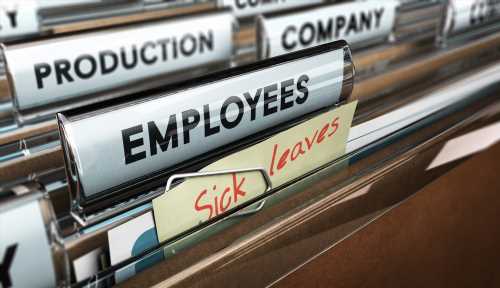In a recent study posted to the medRxiv* preprint server, researchers in Denmark examined associations between coronavirus disease 2019 (COVID-19) and sick leave post-acute infection.

Study: Covid-19 and post-acute sick leave: a hybrid register and questionnaire study in the adult Danish population. Image Credit: OlivierLeMoal/Shutterstock.com

 *Important notice: medRxiv publishes preliminary scientific reports that are not peer-reviewed and, therefore, should not be regarded as conclusive, guide clinical practice/health-related behavior, or treated as established information.
*Important notice: medRxiv publishes preliminary scientific reports that are not peer-reviewed and, therefore, should not be regarded as conclusive, guide clinical practice/health-related behavior, or treated as established information.
Background
Long COVID is defined as the persistence of post-acute symptoms in people previously infected with severe acute respiratory syndrome coronavirus 2 (SARS-CoV-2). Up to 20% of infected individuals are estimated to develop long COVID.
A prior study identified sick leave as a potential indicator of long COVID symptoms in Denmark. Still, the extent to which these symptoms translate to working ability is poorly defined.
About the study
In the present study, researchers evaluated the associations between COVID-19 and sick leave following acute infection in the adult Danish population.
Data were used from the nationwide EFTER-COVID (AFTER-COVID) survey, initiated in August 2021, to assess public health during the COVID-19 pandemic, focusing on long COVID.
Danish residents were invited to participate via a national digital mail system based on SARS-CoV-2 reverse-transcription polymerase chain reaction (RT-PCR) test results in the Danish microbiology database.
Test-negative controls lacking a positive test result in the database at any time before the survey were randomly selected. This analysis included participants who took the survey nine months after their RT-PCR test. The survey data were integrated with register-based data on age, sex, vaccination, COVID-19 test results, reinfections, and comorbidities.
The questionnaire was designed for information on participants' baseline characteristics and sick leaves(s) between test and survey dates. The team obtained data on inpatient and outpatient diagnoses from the Danish National Patient Register (DNPR).
All participants were asked if they took sick leave at the time of testing or after that. Those responding yes were asked to indicate the duration and whether the leave was part- or full-time.
The prevalence of substantial full- or part-time sick leave, viz., full- or part-time sick leave for more than four weeks after infection, was compared between test-positive and -negative subjects using risk differences.
Findings
Overall, 106,917 out of 294,035 invitees completed the survey nine months after the COVID-19 test. After exclusions, the study population comprised 88,818 participants, including 37,482 individuals who were SARS-CoV-2-positive. They were, on average, aged 45; most participants (64.3%) were females.
Less than 1% received at least one vaccine dose for COVID-19. Around 16.6% of participants were obese. Depression, anxiety, and high blood pressure were the other frequent pre-existing conditions. The prevalence of substantial sick leave was higher among test-positive subjects at 4.5% compared to 1.4% among controls.
It was similar across age groups in controls but increased with age in infected participants. Of note, 21% of test-positive individuals who took a substantial sick leave were diagnosed with long COVID, compared to 1.6% of infected individuals who did not take the leave. Infected individuals had a higher risk of taking a substantial full-time sick leave than controls.
The risk difference was attenuated when substantial sick leave was increased and defined as at least six months. Risk differences were higher for females than males and individuals aged 50 or above than the general population. The highest risk differences were for individuals with fibromyalgia, common obstructive pulmonary disease (COPD) or other lung diseases, and diabetes.
Healthcare workers had a larger risk differently than the general population. Infected individuals were also more likely to take a substantial part-time sick leave than controls.
However, the risk of a substantial part-time sick leave was lower for people aged 50 or above than that for substantial full-time sick leave but was similar to the general population.
Conclusions
The team noted that SARS-CoV-2-infected individuals had an increased risk of taking a substantial sick leave. More than a fifth of infected individuals also had a long COVID diagnosis. The study's major limitations include the self-reporting design and potential recall bias.
Moreover, the duration of sick leave was not solely attributable to long COVID, as the questionnaire captured sick leave status in general. Further, participation bias was also likely, given that individuals with poor health or symptoms expressed more interest in participating.
Taken together, the findings suggest that among SARS-CoV-2-infected subjects, an additional 33 persons per 1,000 took a substantial sick leave between one and nine months post-acute infection compared to controls. Females, older adults, and those with pre-existing conditions such as fibromyalgia, obesity, and COPD were affected the most.

 *Important notice: medRxiv publishes preliminary scientific reports that are not peer-reviewed and, therefore, should not be regarded as conclusive, guide clinical practice/health-related behavior, or treated as established information.
*Important notice: medRxiv publishes preliminary scientific reports that are not peer-reviewed and, therefore, should not be regarded as conclusive, guide clinical practice/health-related behavior, or treated as established information.
- Preliminary scientific report. O'Regan, E. et al. (2023) "Covid-19 and post-acute sick leave: a hybrid register and questionnaire study in the adult Danish population". medRxiv., doi: 10.1101/2023.03.31.23288004. https://www.medrxiv.org/content/10.1101/2023.03.31.23288004v1
Posted in: Men's Health News | Medical Science News | Medical Research News | Women's Health News | Disease/Infection News
Tags: Anxiety, Blood, Blood Pressure, Coronavirus, Coronavirus Disease COVID-19, Depression, Diabetes, Fibromyalgia, Healthcare, High Blood Pressure, Microbiology, Obesity, Pandemic, Polymerase, Polymerase Chain Reaction, Public Health, Respiratory, SARS, SARS-CoV-2, Severe Acute Respiratory, Severe Acute Respiratory Syndrome, Syndrome, Transcription, Vaccine

Written by
Tarun Sai Lomte
Tarun is a writer based in Hyderabad, India. He has a Master’s degree in Biotechnology from the University of Hyderabad and is enthusiastic about scientific research. He enjoys reading research papers and literature reviews and is passionate about writing.
Source: Read Full Article
